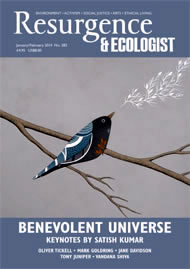After spending 19 years as a senator and the leader of the Australian Greens Party, Bob Brown announced his retirement in 2012. He may be retired, but he has stayed incredibly busy, and one cause he has devoted himself to is the protection of the Tarkine wilderness in his home state of Tasmania.
Bob and I met a week after former Australian Environment Minister Mark Butler approved the go-ahead for a second open-cut mine in the Tarkine. Within days, contractors working for Shree Minerals would barrel into this so-called protected area of Tasmania to begin mining for iron ore.
“It’s a critical time for the Tarkine,” Bob warned, “as it is for so much of the world’s environment. But if we, in the wealthiest country on Earth (according to the UN, per capita) can’t protect something like the Tarkine, we certainly can’t ask people in Borneo or West Papua or the Congo or the Amazon to protect their forests.”
The Tarkine is a 447,000-hectare region of wilderness tucked in the north-west corner of Australia’s island state of Tasmania. Bob first ventured into that region in 1972 to search for the Tasmanian tiger, thought to be extinct since 1936. “There had been alleged sightings in the Tarkine,” he recalls. “I was very sceptical but that trip took me right into the Tarkine, and down the coastline, and I saw the rainforest and the pristine rivers and the wildlife…and that has stayed with me these last 40 years.”
With a smile on his face, the former Greens senator describes the huge, old trees that form a cathedral-like canopy over the fern- and lichen-covered understorey. As a temperate rainforest, the Tarkine is lush and green, but it can snow here, even in the summer. Along the coastline, winds from the Roaring Forties produce waves up to 18 metres in height, and crisp, oxygen-rich air. “This is the cleanest air in the world,” Bob says. In 2013, CNN named the Tarkine the greatest remaining wilderness region in the world, and for good reason.
Besides these rich natural surroundings, the Tarkine is a crucial stronghold for the Tasmanian devil, which faces extinction from a contagious facial cancer. The region is also home to the largest freshwater crayfish, the rare spotted-tailed quoll, and the wedge-tailed eagle – a bird with a wingspan of nearly three metres. “I’ve been walking out on the plains of the Tarkine, and had a pair of them fly over,” Bob tells me. “One came down and landed right next to me. It was an amazing experience.”
The Tarkine also contains some of the richest archaeological sites in Aboriginal history. If you walk along the beach, you’ll find stone engravings on the shoreline boulders, Aboriginal hut sites, and middens, which are collections of shells from meals that indigenous people ate hundreds, if not thousands, of years ago. In the 1980s, Bob put in a request with the Aboriginal community to name the region after the Tarkineer people who once lived along the rocky and sandy coastline.
But everything in the Tarkine – the rainforests, the wildlife, the human heritage – could be obliterated by mining. The Australian Federal Court actually found the initial Shree Mineral mining application to be unlawful, but Butler granted fresh approval for the open-cut mine. Approximately 57 more applications for mineral exploration are in the pipeline for the Tarkine, including inside the rainforest heartland.
Bob has been acting as an ambassador for the Tarkine, working with local groups like the Tarkine National Coalition and the Wilderness Society to raise awareness. He has also launched photographer Chris Bell’s recent book, The Tarkine, across Australia. He firmly believes the best way to save the Tarkine is to get the area better known, and to get more people to visit.
Surprisingly, many Australians don’t know about the Tarkine, even those living in Tasmania. “People have to know about a place,” Bob says. “They won’t simply respond to a protest. They’ll respond to a place that you’re protesting for.” He hopes that if enough people visit, support will grow for the region, and the Tarkine will get the World Heritage status it deserves. Already, the number of visitors to Tasmania is on the increase and there is the potential to grow these figures even further. “We have to recognise that in Tasmania, there’s 30,000 jobs in tourism and hospitality,” Bob says. “There’s less than 1,000 jobs in logging and mining put together, and it’s dropping rapidly.”
Of course, not everyone will get to see somewhere like the Tarkine for themselves, which is why books and films about the area play a key role in its protection. But Bob can’t over-emphasise the importance of spending time in Nature: “What worries me about environment groups these days is that they’re office-based. You’ve got to run your campaigns through the media, and through contact with the public. But go out and spend a night in the place, or with the creatures you’re meant to defend. It’s hugely empowering.”
For Bob, Nature has been the true source of an endless well of optimism, keeping him empowered throughout his career as a Greens politician and an environmental campaigner. “If you go to the Tarkine, and spend a night listening to the owls calling, and you listen to the scurry of the native creatures, and if a rainstorm comes across…it’s a cause for rapture with this planet…and potent cause for us to want to fight for the Tarkine.”







